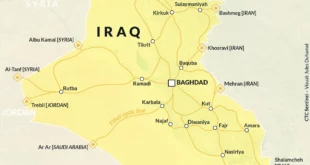BAGHDAD — The rubble-filled streets of the southwestern Baghdad neighbourhood of Bayaa were filled with young men waving Shiite flags and dancing to the pulsating beat of a popular song.“This is what we call not good,” said Captain Timothy Wright as his patrol roared into the neighbourhood in response to panicked phone calls from Sunni residents.
“Those flags weren’t there yesterday,” he said pointing at the colourful Shiite banners draped on the Fatah Basha Mosque, one of the rare Sunni mosques left in the area.
Residents said they were just celebrating the replacement of a Kurdish battalion of the Iraqi army with an Arabic-speaking unit of the mostly Shiite National Police — but Sunni inhabitants feared it was a final attempt to push them out.
In southwest Baghdad, US forces have been delicately negotiating between the warring factions and trying to maintain stability and the remnants of the city’s once-cosmopolitan mix of peoples. Much of the troubled capital’s violence is concentrated in these mixed sectarian neighbourhoods south of the airport road where Sunni and Shiite residents, and their armed allies, are battling each other.
“Right now we are stuck in the middle holding them apart at arms length, and trying to placate both sides,” said Wright, whose Delta company of the 1st battalion, 28th Infantry regiment is part of the four-month-old surge to stabilise the capital.
Violence, usually by the Shiite Mahdi Army, in this densely packed neighbourhood dropped to a low following a sweep by US forces in early May but now it is on the rise again.
“Since we’ve established some semblance of security, Sunni families have come back which doesn’t please the Mahdi Army very much since they were the ones who threw them out to begin with,” said Major Erik Overby, the battalion executive officer. With the news of evictions come the retaliations. Two car bombs, believed to be the work of Sunni insurgents, have ripped through Bayaa in the past weeks killing dozens.
The position of the few remaining Sunnis in Bayaa is particularly precarious and the sectarian battles of the past year have taken their toll. Out of five Sunni mosques in the area, only two are left.
However, on the next day, the Muslim day of prayer, gunmen blew up the Fatah Basha mosque, which was the last Sunni Mosque still in use. The Kurdish battalion had guarded the remaining two closely, a task that then fell to the National Police. Experience has shown that when the mosques go, the population soon follows.
In the northern half of Bayaa where the Sunnis live, shops are shuttered, trash lies uncollected, and few people are out on the streets.
Even after the police took down the Shiite flags, the Sunni mosques remained empty of worshippers, their outer walls decorated with the remnants of posters from the December 2005 elections — a more hopeful time before the sectarian wars started.
Throughout the day’s patrol, the Americans keep checking on the new guardians of the area. The policemen, wearing mismatched camouflage uniforms, sandals and only occasionally body armour, had promised to defend the mosques.
The US army’s “hold and build” strategy to stabilise Baghdad relies on forces like the National Police to maintain control in areas after they have been cleared.
Yet top commanders have admitted that in some cases, the police have not been up to the task, and armed groups have returned to cleared areas.
Near the bullet-spattered street of the mosque, a woman and her daughter come back to check on the house they had abandoned when the violence worsened. “You don’t know what it is like, everyday there are people who want to kill us,” she told Captain Wright.
When asked if there is anything the US troops could do, she began to cry. “I don’t want anything from you, just to sleep through the night in safety.” The captain hands her a card with a telephone number on it to call in case of emergency — the same number some Sunnis called when the “celebrations” started earlier that day. A call comes in from a distraught woman whose home has been shot up and her father kidnapped and killed. When the soldiers escort her back to the house, she asks for help in moving her remaining possessions to a relative’s home elsewhere. Around her neck, bright against her black clothing, is a gold pendant in the shape of Iraq — last year’s fashion accessory calling for national unity.
In the southern part of the neighbourhood the shops are open and the streets are bustling with people while graffiti supporting the Mahdi Army and its leader, populist cleric Moqtada Sadr, adorn the walls.
A local Shiite imam invites the Americans to attend a small neighbourhood meeting of some 50 Sunnis and Shiites to discuss their concerns about the area.
While children played in the streets, locals bombarded Wright with questions and complaints. They want a checkpoint opened on the main market street to improve security and so shops could reopen for business.
“You come and promise all these things, to bring electricity, and security but then nothing happens,” one angry young man said.
“We don’t need more promises.” An elderly man in a wheelchair, however, calms the boisterous crowd and he explains to Wright the importance of the market street.
“The market is the heart of this neighbourhood, come walk it with me some time,” Abu Hussein said and the two promised to work together to bring life back to the area.
“Maybe this is a breakthrough,” said a cautiously optimistic Wright afterwards. “Maybe this is one of those influential guys we’ve been looking for,” in their efforts to engage with the locals.
 Eurasia Press & News
Eurasia Press & News


